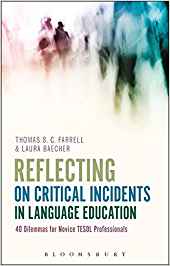May 2018 – Volume 22, Number 1
Reflecting on critical incidents in language education:
|
|||
| Author: | Thomas S. C. Farrell & Laura Baecher (2017) |  |
|
| Publisher: | New York, NY: Bloomsbury Academic. | ||
| Pages | ISBN-13 | Price | |
|---|---|---|---|
| 176 pages | 978-1474255837 (paper) | $26.95 USD | |
Teacher preparation programs build a pedagogical base for candidates; however, they cannot prepare pre-service teachers for every situation. An important part of any career is learning on the job, which is why preparation and continued support are vital for novice teachers working in second language (L2) contexts. In Reflecting on Critical Incidents in Language Education: 40 Dilemmas for Novice TESOL Professionals, Thomas S. C. Farrell and Laura Baecher address 40 common situations educators may encounter at some point in their careers. These situations are divided thematically into chapters: (1) creating a positive classroom community, (2) curriculum development, (3) teaching mixed-level/large classes, (4) classroom management, (5) developing students’ speaking skills, (6) developing students’ reading skills, (7) developing students’ listening skills, (8) developing students’ writing skills, (9) addressing workplace challenges, and (10) professional development.
Each chapter begins with a description of its theme followed by detailed accounts of four common dilemmas. Farrell and Baecher selected these dilemmas from a variety of L2 classroom contexts ranging from K-12 English as a Second Language (ESL), English as a Foreign Language (EFL), higher education, and adult education settings. This variety ensures that they are relatable to many educators, including non-language teachers. The chapters are divided further into four scenarios that focus on a range of classroom situations. Each scenario includes the following elements: (1) inquiry, (2) previewing the issues, (3) the teacher’s dilemma, (4) the teacher’s attempt to problem-solve, (5) reflecting on the incident, (6) follow-up, and (7) exploring the issue. An inquiry question that identifies the main issue to be discussed in the scenario introduces each dilemma and is followed by a list of sub-questions, which encourage readers to critically think about their own teaching experience and potential situations they may encounter. This section is followed by an incident that is directly related to the inquiry question and chapter theme.
Each dilemma provides a description of situations presented from a teacher’s perspective and includes specific classroom details. The incident accounts are also followed by an explanation of how the novice teacher attempted to solve the issue presented. The authors ask several questions related to the dilemma to further engage readers in analysis. The incident concludes with a follow-up section, which describes how the novice teacher continued to process the challenge, any further resolutions made, and an evaluation of their initial attempt to address the issue. Sometimes these challenges do not have concrete solutions, but they provide directions for further reflection and ways to grow as a teacher.
This book also could be easily used either in a mentoring situation or during student teaching to discuss classroom challenges. For example, both previewing the issue and reflecting on the incident questions could facilitate discussion about classroom struggles in a small group or larger professional development environment. A majority of the chapters would be useful not only to language teachers, but also to general education and content-area teachers who have English Learners (ELs) in their classrooms. These teachers should be well-versed on how to educate all students, and this book provides helpful tools in how to best serve this population.
One example of how this book would be useful to a variety of teachers is the first themed chapter, which focuses on creating a productive learning community. The incidents within this chapter include building good relationships with difficult students, addressing cultural tensions among students, establishing boundaries with students, and encouraging collaboration in classroom activities. Most teachers will encounter these challenges at some point in their careers. The different dilemmas described in this book stem from a variety of contexts, including an international private ESL classroom with 11 year-old students, an intermediate level ESL high school class focusing on social studies content, an EFL class in a language school with young adults, and an EFL class with children ages 8-9. Through this variety of settings, readers should be able to draw helpful information and strategies from each incident.
Because this text is meant to address issues of all language teachers, some incidents may seem irrelevant to someone teaching in a different context, grade level, and location. However, creative and strategic thinking on the part of readers can help them see how the challenge relates to their classroom. For example, my experience as a secondary content teacher in the United States made some of the international EFL and adult descriptions seem less applicable to my experiences. However, some of the incidents from EFL classrooms resonated with my classroom struggles, such as having students in class who are too shy to participate in activities. Critically thinking about each incident allows teachers to consider how the descriptions could be relevant to their classrooms and experiences.
Reflecting on Critical Incidents is a valuable resource for educators. This book provides helpful guidance for teachers by addressing common issues that may not be covered in traditional teacher preparation courses. The emphasis on reflection and utilizing the resources of other teachers can encourage readers to grow as educators and critically examine their practice. The book may be used either by pre-service teachers to discuss challenges they will encounter in the field or by novice teachers looking for practical solutions to approach issues they are facing for the first time. Regardless of how this book is utilized, it is a powerful resource for educators to develop reflective practices.
Reviewed by
Anna Saulsbury-Molina
The University of Texas at San Antonio
<anna.saulsbury-molina![]() my.utsa.edu>
my.utsa.edu>
| © Copyright rests with authors. Please cite TESL-EJ appropriately. Editor’s Note: The HTML version contains no page numbers. Please use the PDF version of this article for citations. |

